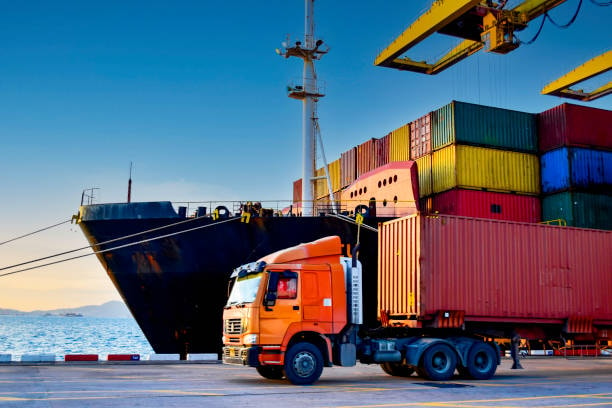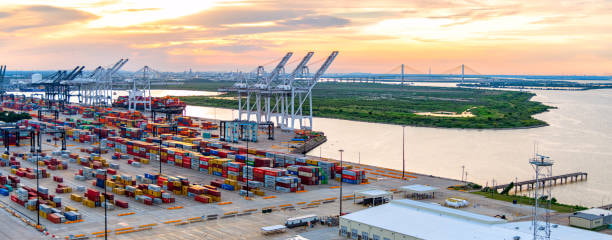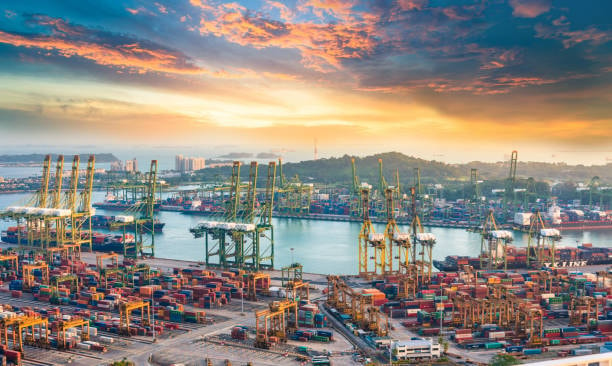All facets of worldwide commerce depend on quick maritime transportation networks which enable international goods transportation. Business owners together with importers and exporters need to understand authentic port-to-port shipping transit times for effective supply chain management and business organization. The duration of cargo and sea freight transit times between two ports depends on multiple elements which become essential knowledge when making shipping decisions.

This blog examines shipping transit determinants along with delivery speed influences from different methods and the customs process before presenting solutions to maximize the shipping time efficiency.
What is Port-to-Port Shipping Transit Time?
A shipment spends its transit time getting between departure and destination ports. The shipping period lasts between port departure of the initial port through the final destination port arrival. These calculations exclude all operations before shipping begins and the procedures from loading through customs clearance and ground transportation.
The period needed for ships to transit ports between locations matters fundamentally because it determines inventory control practices and manufacturing planning and consumer satisfaction expectations. Shipping firms depend on transit time estimates and historical data as the foundation for creating better logistics plans and calculation of costs.
Key Factors Affecting Port-to-Port Shipping Transit Time

A wide range of influencing factors determines the precise transit time estimates total duration required for cargo transportation between ports. These include:
1. Distance Between Ports
The basic determinant of ocean freight transit duration consists of the actual separation between origin and destination port locations. Shipping routes shorter than those which span continents require three to four days to complete while extended continental connections need weeks to complete their journey.
A shipment traveling from Shanghai China to Los Angeles USA requires approximately 12-15 days but Rotterdam Netherlands to Sydney Australia transit time reaches more than 30 days international freight alone.
2. Shipping Route and Transshipment
Certain delivery paths demand transshipment because containers must be loaded onto new boats at specific staging ports. The shipping duration becomes longer when the unloading and storage and reloading of containers occurs during the transshipment process.
Transshipment stops at European or Middle Eastern ports during shipment from Singapore to New York resulting in a noticeable increase of 5 days up to several weeks in transit time.
3. Type of Vessel Used
The selection of vessel type which moves the cargo significantly influences how long shipments need. Multiple shipping vessels operate at different speeds with distinctive performance characteristics between them.
- Warships found widespread use in international transportation as they travel between 16 and 25 knots using container systems.
- Bulk Carriers facilitate raw material transportation of coal and grain by cruising at a speed range between 12-15 knots.
- RoRo Ships navigate at a steady pace while moving vehicles and wheeled cargo.
Vessels that travel at increased speeds need to pay more expenses for port-to-port delivery although their average transit times and duration shortens.
4. Weather and Seasonal Conditions
Severe meteorological phenomena including hurricanes along with typhoons and monsoons result in adverse weather conditions and in considerable postponements of shipping delivery durations. Strong sea conditions reduce vessel speed and sometimes prompt ships to choose unsafe alternative maritime routes due to existing hazardous meteorological conditions.
Shipping transit times lengthen during peak holiday times since ports operate with heavy congestion and high volumes result in delayed departures and longer unloading proceedings at destination ports.

5. Port Congestion and Efficiency
The full shipping time calculator transit duration depends heavily on the operational efficiency of the sending port along with the receiving port. Ports that use the combination of modern infrastructure with automated loading systems and high container capacities can complete their shipments with accelerated speed.
Shipping delays can occur at busy ports because high congestion levels combine with labor strikes and insufficient port facilities to extend waiting periods for berthing procedures alongside unloading operations and customs clearance port processing processes.
6. Customs Clearance and Regulations
The length of procurement at destination ports extends transit time when shipments need extra verification or additional documentation checks or import duty clearance or tax calculations.
The time needed for customs clearance extends when documents lack completeness and when authorities invoke trade bans or whenever exports draw official inspections.
7. Shipping Carrier and Service Type
The level of service stands different between transportation companies who provide expedited delivery methods and basic or economical options. Goods transported by premium carriers will arrive quicker due to their superior routing methods and efficient delivery systems and basic shipping choices will deliver cargo at a slower pace.
The selection process for carriers together with service types depends on shipping needs as well as budget and delivery urgency.
Different Shipping Methods and Their Transit Times

Multiple international trade shipping solutions exist but lead to varying freight transit times and durations from port to port.
1. Full Container Load (FCL) Shipping
The rental of full containers as a single shipment solution makes up FCL shipping operations. The separate nature of FCL and shipping process enables quick delivery since it does not combine cargo with other shipments like less-than-container-load (LCL).
2. Less-Than-Container Load (LCL) Shipping
When shippers opt for LCL services they share their goods inside a shipping container with other business clients. The advantage of ocean freight transit this method is its affordability yet the drawback stems from its increased travel duration that arises from connecting operations at both origin and destination terminals.
3. Air Freight vs. Sea Freight

Air freight moves shipments at a speed that costs substantially higher than ocean freight transit times the rates for sea freight transportation.
- Air Freight service provides transit periods between 1 to 7 days based on transportation distances.
- Shipping through the sea requires transit durations between days and weeks according to shipping route together with selected methods.
How to Optimize Port-to-Port Shipping Transit Time

Following these suggestions will minimize delivery delays and enhance shipping performance:
1. Plan Shipments in Advance
Future bookings for shipments prevent delays caused by peak seasons by guaranteeing both fleet space availability and vessel capacity.
2. Choose Direct Routes When Possible
Direct shipping routes help avoid delay time that comes from transshipping through multiple ports during transportation.
3. Work with Reliable Shipping Partners
Working with a shipping company that shows expertise along with proven success delivers better transit outcomes and brings fewer surprises during this mode of transportation.
4. Ensure Proper Documentation
Shipping documents which contain accurate and total information help avoid customs delays during shipment processes. Export documents consist of the bill of lading as well as commercial invoice together with packing list and certificates of origin.
5. Monitor Shipments and Stay Updated
Your ability to detect and counter shipping delays improves through continuous communication with transportation agents combined with tracking system utilization.
Conclusion
The duration from one shipping terminal to another represents a vital component for worldwide trade and logistics operations. The ability to forecast shipping costs and delivery schedules depends on comprehending both transportation distance and delivery vessel type as well as weather conditions and customs processing which factors affect transit time and port operational efficiency. Different shipping methods that include FCL and LCL shipping together with air and sea freight shipping affect both cost and delivery times. Reliable shipping operations result from carrying out careful planning and route optimization and partnering with dependable transportation services which reduces transit time and strengthens supply chain stability.




